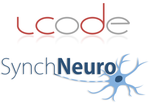|
|
|
SpeakersHere is the confirmed list of speakers:
Below, you can find some biographic details about these speakers. Click here to have access to the abstract of their talk.
Bruno Cessac Bruno Cessac is doctor in theoretical physics and Directeur de Recherches (Senior Research Scientist) at INRIA Sophia-Antipolis. His research interests are modeling and analysis of large sized dynamical systems arising in various fields such as physics and biology. His main interest concerns neuronal networks dynamics. He has developed methods combining dynamical systems theory, statistical physics and ergodic theory allowing to classify dynamics arising in canonical neuronal networks models like integrate and fire models or firing rate models. He is currently applying these methods on the study of synaptic and intrinsic plasticity, spike coding, spike train statistics analysis, neural masses dynamics, with applications to vision. Alain Destexhe The research conducted in Alain Destexhe's laboratory stands at the interface between several disciplines, such as biophysics, physics, computer science and neuroscience. The themes investigated range from the microscopic (single neurons) to the macroscopic (networks or populations of neurons) aspects of the central nervous system function. At the single cell level, we use theoretical methods and computer-based simulation techniques to explore the complex behavior of cortical and thalamic neurons and understand their integrative properties. At the network level, we try to understand the collective behavior of neuronal populations, and how information in processed and represented. We also study the genesis of sleep rhythms, their physiological role and their perversion into pathological rhythms such as absence epileptic seizures. Finally, we use theoretical frameworks (such as stochastic dynamical systems) to conceive methods to deduce hidden information in experimentally-recorded signals. This research is only possible through a very tight collaboration with experimentalists recording single cells (intracellular measurements) and network behavior (EEG, LFP and optical imaging). David Hansel David Hansel is a physicist, Directeur de Recherche at the CNRS. He has worked in the field of Neurophysics and Computational Neuroscience for more than 20 years. His scientific interests include modeling of large neuronal networks, the collective dynamics in cortex, the emergence of synchronous activity, mechanisms for persistent activity, and the origin of the selective response of neurons in cortex and in the basal ganglia. David Hansel is the co-leader (with Carole Levenes) of the Cerebral dynamics, learning and memory research group at Center for Neurophysics, Physiology and Pathology (CNRS, Université Paris Descartes) and co-director (with Israel Nelken, Hebrew University of Jerusalem) of the France-Israel Laboratory of Neuroscience. Axel Hutt Axel Hutt did his PhD in Theoretical Physics at the University of Stuttgart and the Max Planck Institute for Cognitive Neuroscience in Leipzig. Since 2007 he works at INRIA Nancy and since beginning 2013 he is head of the INRIA team Neurosys. Dimitris Pinotsis Dr Dimitris Pinotsis is a Senior Research Associate at the Wellcome Trust Centre for Neuroimaging at University College London (UCL). He holds a PhD in Mathematics from the Department of Applied Mathematics and Theoretical Physics (DAMTP) of the University of Cambridge. He also holds a BSc in Physics from the University of Athens and a MA in Mathematics from the University of Cambridge. Dimitris’ research, funded by EPSRC and the Wellcome Trust, spans diverse areas including theoretical neurobiology, nonlinear systems in mathematical physics, boundary value problems for integrable equations in fixed and time-dependent domains, hypercomplex numbers and the simulation and analysis of neuroimaging data. In recent work, Dimitris exploits modern mathematical methods to answer questions in molecular neuroscience, visual perception, attention, decision-making, electro-encephalography and brain oscillations. He is also interested in applications of these methods to other areas, in particular deep learning and predictive coding. Dimitris is an Associate Editor for Frontiers in Computational Neuroscience and an Expert Reviewer for US Air Force Office of Scientific Research. Peter Wellstead Peter Wellstead trained in mechanical and electrical engineering with Marconi Instruments Ltd with graduate studies at Warwick University. His main interest is understanding systems through mathematical modelling and analysis, and in addition to several industrial appointments, he has worked at CERN, University of Manchester Institute of Science and Technology and the National University of Ireland Maynooth. In 2004 he was appointed Science Foundation Ireland Research Professor of Systems Biology at the Hamilton Institute where his group studied the causal and pathogenic mechanisms of Parkinson’s disease. He retired from the Hamilton Institute at the end of 2009 but continues to work on Parkinson’s disease. |


